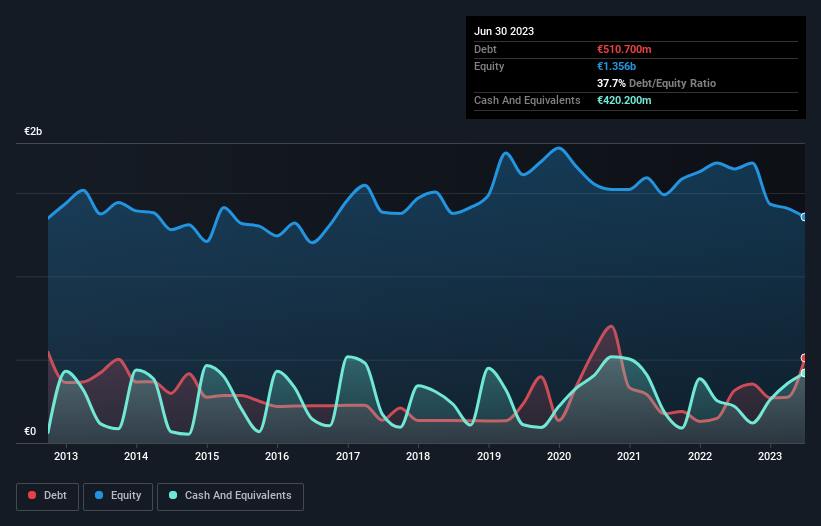- Finland
- /
- Auto Components
- /
- HLSE:TYRES
These 4 Measures Indicate That Nokian Renkaat Oyj (HEL:TYRES) Is Using Debt Reasonably Well
Warren Buffett famously said, 'Volatility is far from synonymous with risk.' When we think about how risky a company is, we always like to look at its use of debt, since debt overload can lead to ruin. Importantly, Nokian Renkaat Oyj (HEL:TYRES) does carry debt. But is this debt a concern to shareholders?
When Is Debt A Problem?
Generally speaking, debt only becomes a real problem when a company can't easily pay it off, either by raising capital or with its own cash flow. In the worst case scenario, a company can go bankrupt if it cannot pay its creditors. However, a more frequent (but still costly) occurrence is where a company must issue shares at bargain-basement prices, permanently diluting shareholders, just to shore up its balance sheet. Of course, the upside of debt is that it often represents cheap capital, especially when it replaces dilution in a company with the ability to reinvest at high rates of return. When we examine debt levels, we first consider both cash and debt levels, together.
View our latest analysis for Nokian Renkaat Oyj
What Is Nokian Renkaat Oyj's Net Debt?
The image below, which you can click on for greater detail, shows that at June 2023 Nokian Renkaat Oyj had debt of €510.7m, up from €315.7m in one year. On the flip side, it has €420.2m in cash leading to net debt of about €90.5m.

A Look At Nokian Renkaat Oyj's Liabilities
The latest balance sheet data shows that Nokian Renkaat Oyj had liabilities of €401.9m due within a year, and liabilities of €502.0m falling due after that. Offsetting these obligations, it had cash of €420.2m as well as receivables valued at €350.4m due within 12 months. So its liabilities outweigh the sum of its cash and (near-term) receivables by €133.3m.
Of course, Nokian Renkaat Oyj has a market capitalization of €1.10b, so these liabilities are probably manageable. Having said that, it's clear that we should continue to monitor its balance sheet, lest it change for the worse.
We measure a company's debt load relative to its earnings power by looking at its net debt divided by its earnings before interest, tax, depreciation, and amortization (EBITDA) and by calculating how easily its earnings before interest and tax (EBIT) cover its interest expense (interest cover). Thus we consider debt relative to earnings both with and without depreciation and amortization expenses.
Nokian Renkaat Oyj has very little debt (net of cash), and boasts a debt to EBITDA ratio of -0.90 and EBIT of 10.3 times the interest expense. So relative to past earnings, the debt load seems trivial. In fact Nokian Renkaat Oyj's saving grace is its low debt levels, because its EBIT has tanked 62% in the last twelve months. Falling earnings (if the trend continues) could eventually make even modest debt quite risky. When analysing debt levels, the balance sheet is the obvious place to start. But it is future earnings, more than anything, that will determine Nokian Renkaat Oyj's ability to maintain a healthy balance sheet going forward. So if you're focused on the future you can check out this free report showing analyst profit forecasts.
But our final consideration is also important, because a company cannot pay debt with paper profits; it needs cold hard cash. So the logical step is to look at the proportion of that EBIT that is matched by actual free cash flow. During the last three years, Nokian Renkaat Oyj produced sturdy free cash flow equating to 52% of its EBIT, about what we'd expect. This free cash flow puts the company in a good position to pay down debt, when appropriate.
Our View
Nokian Renkaat Oyj's EBIT growth rate was a real negative on this analysis, although the other factors we considered were considerably better. There's no doubt that its ability to handle its debt, based on its EBITDA, is pretty flash. Looking at all this data makes us feel a little cautious about Nokian Renkaat Oyj's debt levels. While we appreciate debt can enhance returns on equity, we'd suggest that shareholders keep close watch on its debt levels, lest they increase. The balance sheet is clearly the area to focus on when you are analysing debt. But ultimately, every company can contain risks that exist outside of the balance sheet. For example - Nokian Renkaat Oyj has 1 warning sign we think you should be aware of.
Of course, if you're the type of investor who prefers buying stocks without the burden of debt, then don't hesitate to discover our exclusive list of net cash growth stocks, today.
Valuation is complex, but we're here to simplify it.
Discover if Nokian Renkaat Oyj might be undervalued or overvalued with our detailed analysis, featuring fair value estimates, potential risks, dividends, insider trades, and its financial condition.
Access Free AnalysisHave feedback on this article? Concerned about the content? Get in touch with us directly. Alternatively, email editorial-team (at) simplywallst.com.
This article by Simply Wall St is general in nature. We provide commentary based on historical data and analyst forecasts only using an unbiased methodology and our articles are not intended to be financial advice. It does not constitute a recommendation to buy or sell any stock, and does not take account of your objectives, or your financial situation. We aim to bring you long-term focused analysis driven by fundamental data. Note that our analysis may not factor in the latest price-sensitive company announcements or qualitative material. Simply Wall St has no position in any stocks mentioned.
About HLSE:TYRES
Nokian Renkaat Oyj
Develops and manufactures tires for passenger cars, trucks, and heavy machineries in Nordics, the rest of Europe, the Americas, and internationally.
Reasonable growth potential and fair value.
Market Insights
Community Narratives





